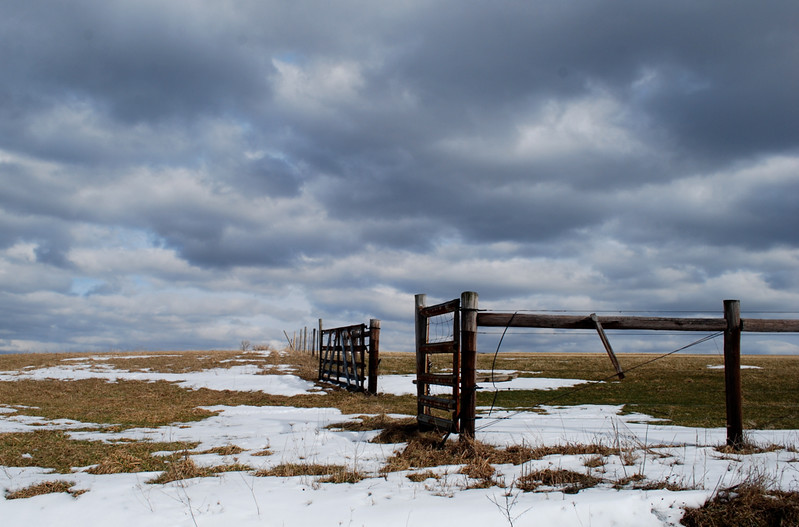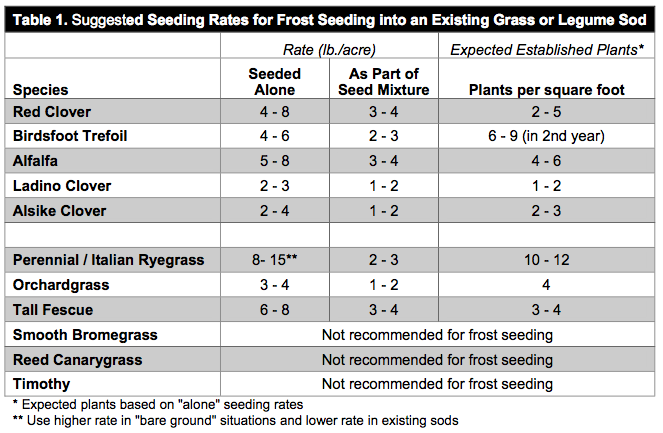Photo Credit: PxHere
Wise pasture managers understand the benefits of frost seeding and know it’s a handy—and efficient—tool in their arsenal. It is a simple, inexpensive way to improve the stand quality of your pastures and food plots by seeding in the winter while the ground is still frozen.
If your pastures or forage plots look a little lame, and you’re searching for a suitable way to improve your forage yields or increase the pasture’s species mix, you’ve come to the right place. Let’s talk about what frost seeding is, why it’s so valuable, and some easy, effective tips for success!
What is Frost Seeding?
Jennifer explained frost seeding well in our article, What is Frost Seeding & How Can It Help My Farm?
“Frost seeding is the smart but shamelessly lazy way to improve your farm pastures and forage plots. By spreading hardy seed at the right time, you allow nature’s ground-freezing and thawing cycle to work the seed into the soil for you.
Have you ever noticed that muddy pasture areas tend to stand a little taller when frozen? You may remember from elementary school science that ice takes up more space than liquid water. That’s why winter’s freezing temperatures cause our soils to expand. The soil heaves up and cracks when the surface water freezes overnight and then retreats and closes during the daytime thaw. This natural process sucks surface seeds into the soil for germination without any human effort nor tillage. It’s the cheapest farm labor you’ll find. Take advantage of nature’s free labor!”
 Photo Credit: vidarnm | Deposit Photos
Photo Credit: vidarnm | Deposit Photos
Frost seeding inter-seeds forages and grasses into the unworked ground of pastures and forage plots by scattering seeds across the soil surface. As the soil freezes and thaws, the heaving action works the seeds into the soil, where they germinate.
It is perhaps the easiest and most inexpensive way to seed existing stands. You’ll see benefits with minimal expenditures.
Why Should You Frost Seed?
In other words, what are the benefits?
Frost seeding is a prime example of the phrase, “work smarter, not harder.” The most obvious benefits are to improve forage yield and increase the species mix on your land.
Beyond that, there are also less apparent benefits. This technique reduces the reliance on machinery, and in turn, the seeding cost decreases.
- It can be done during the typical “downtime” of farming instead of during the spring when task lists are long. Making life easier during planting is always welcome.
- Seeding when the ground is frozen prevents soil compaction from heavy machinery. Instead of using equipment to work the ground and plant, nature does the work.
- Frost seeding negates the need for purchasing a plow to work the ground and a seed
- drill in conventional farming or a no-till planter.
- Improves forage quality by adding legumes to grass stands.
- Maintains stand productivity without needing to till the soil, so there is less “non-grazing” time.
When Should You Frost Seed?
Okay, so hear me out here. With a name like “frost” seeding, you can’t expect to do it when it’s 75°F and sunny. To take advantage of the frost heave, you’ll need to don your heavy winter gear—including insulated workboots and maybe even a hat with ear flaps—and tackle this project in late February or early march. It’s going to be worth it, though!
Keep in mind that those dates aren’t set in stone. We all know that Mother Nature can play games and is sometimes incredibly finicky. But they are a good guideline for when you should plan on frost seeding and then watch what the weather holds.
 Photo Credit: jo(e) | Flickr | CC BY-NC-ND 2.0
Photo Credit: jo(e) | Flickr | CC BY-NC-ND 2.0
The key to timing is scattering seeds when the ground is frozen, without deep snow cover. Ideally, you want to seed in the earlier part of the day when the ground is solid, but the temperatures and sunshine are expected to thaw everything come afternoon and freezes again that night.
The alternating freezing and thawing cycles are known as “honey-combing” and are the driving force behind getting seed into the soil. So we want to take advantage of it.
Essentials Factors for Frost Seeding
Before we get into the tips for successful frost seeding, let’s touch on the three key factors you must incorporate. These aren’t just suggested practices but can easily make or break the practice.
- Good seed-to-soil contact. Good seed-soil contact is necessary for seed germination and seedling emergence. Frost seeding isn’t successful if the seed never reaches the ground.
 Photo Credit: Conservation Media Library | Flickr | CC BY 2.0
Photo Credit: Conservation Media Library | Flickr | CC BY 2.0 - High-quality seed. A high-quality pasture or food plot starts with using the best seed. Buy premium seed—either certified or proprietary—to ensure quality genetics, high germination rates, and low noxious weed content.
- Inoculate legume seed. When introducing a legume species to your pasture or forage plot, inoculate the seed before scattering it. Bacterial inoculant is relatively inexpensive but adds insurance that the roots will be well nodulated and efficient nitrogen fixation occurs.
Easy Tips for Successful Frost Seeding
Now that we’ve covered the what, why, and when of frost seeding, let’s get to the “how.” The following tips aren’t overly involved, but they’ll go a long way toward a successful stand improvement.
- Graze or closely clip the pasture, hay field, or food plot in the fall or early winter to open the stand and expose the soil surface.
- Take soil tests before planting to understand soil fertility. Proper soil pH values and nutrient concentrations are critical for optimal forage production.
- Avoid scattering seeds (especially with fertilizer) across heavy snow, as a fast melt can cause seed runoff.
- Avoid frost seeding on sandy soils that dry out quickly. It works best on loamy and clay soils that retain water.
- Choose grass and forage species with small seeds, germinate rapidly, and grow in cool conditions.
- Don’t mix grass and legume species when broadcasting. Legume seeds are denser and throw farther, resulting in non-uniform distribution.
- Stick to recommended frost seeding rates for legumes, or even drop them slightly. Don’t get overzealous and add too much clover, which can lead to springtime bloat in cattle and other ruminants.
- Know the width of the spread and carefully space your passes when seeding to ensure uniform coverage.
- Use grazing animals to tramp the seed into the soil shortly after broadcasting.
- Control grass and weed competition in the first couple of months of the growing season to allow legume stands to establish adequately. It may be necessary to mow pastures.
- Once the grass starts growing, allow moderate grazing, but avoid close grazing that can compromise the stand.
 Photo Credit: Rawpixel
Photo Credit: Rawpixel
Suggested Seeding Rates
It’s important to remember that germination rates when frost seeding are lower than traditional seeding because of the cooler temperatures and wet soil. However, since you are inter-seeding established stands, the seeding rate doesn’t need to be as high as it would be if you were starting with bare ground.
 Photo Credit: Hippo px | CC0 1.0
Photo Credit: Hippo px | CC0 1.0
To determine your frost seeding rate, you need to consider the amount of ground exposed, the forage species you’re seeding, and the desired stand thickness. After a few attempts at frost seeding, you’ll get a better idea of what seeding rates are best for your land. Since it’s so easy overall, the experimentation with dialing in the seeding rates is worth the minimal effort and cost.
Here are some suggested seeding rates by The University of Wisconsin Extension as a starting point.
Questions?
Now is the time to start planning and getting ready to frost seed. Incorporating this practice into your pasture or food plot management will benefit you.
We understand new practices can be overwhelming when they’re unfamiliar. This is where we can help! Our website contains articles filled with great information on farming and wildlife, and you can always reach out to us directly to talk to one of our experts!
Additional Resources
- The Master Grazer program at The University of Kentucky talks about frost seeding and how it can improve grazing practices.
- Farm and Dairy’s website contains a great article written by Chris Penrose, an OSU Extension Educator, that goes more in-depth about what to plant when frost seeding.
- Mike Rankin of the University of Wisconsin Extension offers an excellent frost seeding guide, including a detailed table of suggested seeding rates and expected established plant stands.
- The University of Kentucky has a short, knowledgeable article on critical elements for frost-seeding legumes.
- PennState Extension also offers this great article on using frost seeding as an alternative to tillage to renovate pastures.




